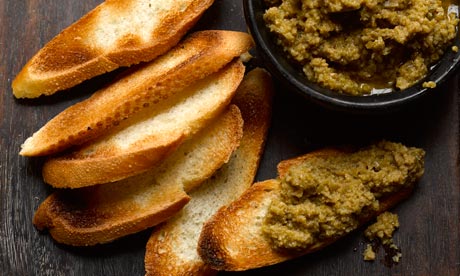Asparagus Salad With Ginger-Citrus Vinaigrette

For the asparagus
- 1 lb (454gr) asparagus spears (1 bunch) – bottom of stems snapped off
- 1 tablespoon California Olive Ranch extra-virgin olive oil
- sea salt to taste
For the vinaigrette
- 1 teaspoon finely grated fresh ginger (use microplane grater)
- 1 teaspoon finely grated orange zest (use microplane grater)
- 1 tablespoon brown rice vinegar
- 1 tablespoon lime juice
- 1/8 teaspoon ground cayenne
- 1/8 teaspoon sea salt
- 3 tablespoons California Olive Ranch extra-virgin olive oil
- 1 tablespoon toasted sesame oil
For the salad
- 1 teaspoon sea salt for blanching
- 1 cup snow peas (3 oz) (85gr) – stem end trimmed and left whole
- 1 large Valencia or navel orange
- 1 large handful (3 oz) (85gr) baby arugula
- 2 tablespoons sesame seeds – toasted (see cook’s note)
Directions
Step 1: Preheat the oven to 500ºF (260ºC). Move
rack to the top of the oven. Spread the asparagus on a jellyroll pan.
Brush with the olive oil and sprinkle with salt. Bake for 8 to 10
minutes (depending on their size) until the tips begin to brown. The
stalks should still be bright green. Remove from pan and let cool to
room temperature.
Step 2: In a small bowl, whisk ginger, zest, vinegar, lime juice, cayenne, salt, olive oil, and sesame oil until well blended. Set aside.
Step 3: Fill a large bowl with cold water and several ice cubes. Bring 1 quart of water to a boil. When the water is boiling, add the salt and snow peas. Boil for 2 minutes. The snow peas will turn bright green. Drain and transfer to the cold water bath. When the snow peas are chilled through, drain and spread on paper towels. Set aside.
Step 4: Peel the orange to its flesh and cut in half lengthwise. Remove the seeds, pith and threads in the center, and slice each half crosswise in 1/8″ thick slices. Set aside.
Step 5: Place the arugula leaves in the center of each plate. Tuck a few snow peas and orange slices between the leaves. Top with the roasted asparagus. Drizzle with the vinaigrette and sprinkle with the toasted sesame seeds. Serve immediately.
Step 2: In a small bowl, whisk ginger, zest, vinegar, lime juice, cayenne, salt, olive oil, and sesame oil until well blended. Set aside.
Step 3: Fill a large bowl with cold water and several ice cubes. Bring 1 quart of water to a boil. When the water is boiling, add the salt and snow peas. Boil for 2 minutes. The snow peas will turn bright green. Drain and transfer to the cold water bath. When the snow peas are chilled through, drain and spread on paper towels. Set aside.
Step 4: Peel the orange to its flesh and cut in half lengthwise. Remove the seeds, pith and threads in the center, and slice each half crosswise in 1/8″ thick slices. Set aside.
Step 5: Place the arugula leaves in the center of each plate. Tuck a few snow peas and orange slices between the leaves. Top with the roasted asparagus. Drizzle with the vinaigrette and sprinkle with the toasted sesame seeds. Serve immediately.
Cook’s note: To toast the sesame seeds – Heat a small frying pan to medium-high heat. Add the sesame seeds and sauté for 2 to 3 minutes until light-golden, stirring or shaking the pan constantly. Transfer to a small bowl and set aside until ready to use.
Recipe and photo courtesy of Viviane Bauquet Farre of Food & Style
Follow us on Twitter: MemphisFoodGuy















